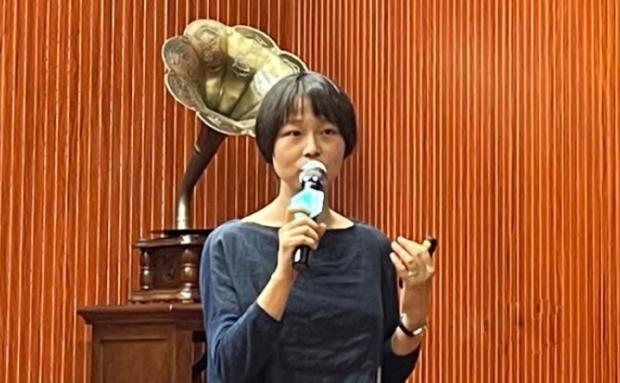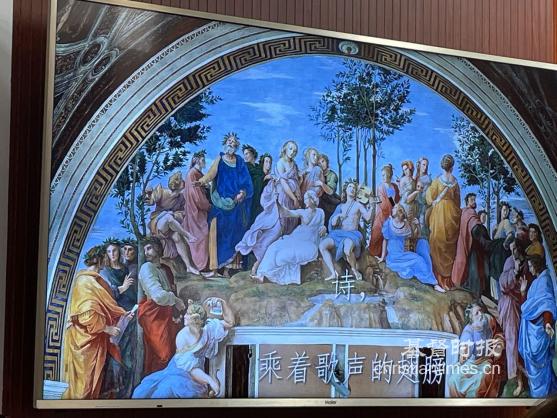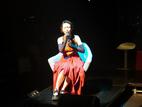A language professor gave an open lecture titled "Poetry, Riding the Wings of Singing: German and Austrian Classical Music and Literature" in Shanghai, sharing that art was more than a pleasure.
The lecture was given by Jiang Linjing, an associate professor of German Language and Literature Department of Fudan University, and Ph.D. holder of German Literature from Heidelberg University, on June 4.
In the lecture, Professor Jiang whose research direction entails political science and theology in German literature, the interrelation between and German and Austrian classical music and literature, and German poetry in the 19th-20th century period, first introduced why the two art forms - literature and music - should be considered together, and why they should not be dealt with separately.
She took Raphael's famous wet mural, The Parnassus, as a supportive argument to explain that at the center of the painting is Apollo, wearing a moon crown and holding a lyre, surrounded by nine muses, nine ancient and nine contemporary poets. As the patron saint of musicians and poets, Apollo's lyre represented the combination of poetry and music. The musical instrument in his hands is the 'lyre' in English, which is the etymology of lyrical poetry, while a lyrical poem contains the art of poetic singing. Ancient poetry was not printed in a notebook for people to read, but needed to be sung, and the singing was integrated with the text itself.
The singing tradition of ancient lyrical poetry was also reflected in the painting Orpheus Leading Eurydice from the Underworld, painted by the French landscape painter, Camier Corot, Jiang continued. The painting depicts the Greek musician and poet, Orpheus, escaping from the underworld with his wife Eurydice. As he approaches the boundary of the proper world, Orpheus raises his lyre to declare victory instead of waving swords or other treasures. The lyre is the source of Orpheus's strength accompanied by his narrating and singing.
Orpheus's classic sad stories have been adapted into many musicals, which have deeply influenced many artists and musicians. Professor Jiang played the Italian work Orfeo and Euridice, by German composer Christoph Willibald Gluck in the 18th century. There were bursts of sadness in the expression and singing emotion of the actors, but the melody was pleasing to the eye and fascinating.
Having published a German monograph, Carl Schmitt as Literary Critic, A Metacritical Investigation, and the Chinese translated works of Hoffnung für eine unfertige Welt and What is German Music, Professor Jiang explained that operas were used to serve the upper class to give them entertainment, while French and Italian music paid attention to melodic linear advancement, which was similar to current pop music. The appearance of German and Austrian music in the 18th century gave a paradigm shift in music, believing that music should be regarded as sacred and rigorous, should not serve a certain class only, and should express people's general emotions.
As the co-author of the Chinese commentary collection Sharon's Rose: A Classic Image in English, French and German Trilingual Literature and Painting, she introduced that German and Austrian music produced an artistic form of combining poetry and music - "art songs". Among them, there are two influential poet and composer combinations - Goethe and Schubert, and Heine and Schumann. In 1814, Franz Schubert composed the art song "Gretchen on the Spinning Wheel", based on Faust, written by Johann Wolfgang von Goethe. The song describes Mahogany, who is spinning and thinking of her lover Faust, but unable to meet and be with him. The girl's voice constantly recurs in the song: "I lost my peace and my heart was dull; To never find peace." Although the melody of this song is very simple, the singer's voice echoes with the piano, and the piano imitates the spinning wheel from slow to fast, reflecting the girl's sad state of mind, forming the tension of drama, and bringing the audience into the scene of our poetry.
Similarly, Robert Schumann also appreciated the literary works of poet Heinrich Heine. In 1840, Schumann created the vocal divertimento, Poet's Love, based on the latter's poem, Lyric Intermittent. This year, he married Clara Schumann, whom he had admired for a long time. Schumann confided the joy of getting love through Heine's poems, and integrated the description of nature with his inner world: "In the beautiful May / all buds bloom, while in my heart/love shines. In the beautiful May / all the birds sing, and I confide to him that my thoughts are long." In the performance of divertimento, the piano not only functions as the vocals but also expands the vocals, adding many preludes, interludes, and endings, and excavating and even extending the emotions in poetry through music.
The composer Richard Wagner constructed a new overall art form - "Musick Drama", which is called "Music Drama" in English. He integrated literary theory with character modeling, poetry and writing. According to the love story of the same name adapted by the 13th-century writer Gottfried von Strasbourg, he personally wrote the script and created the famous opera, "Tristan and Isolde", which tells of a love tragedy similar to Romeo and Juliet. Jiang stated that the sublimation of love in the last aria not only showed the feelings of personal love but also described people's universal understanding of love and death. Wagner held that death was not the end, but purification and sublimation of love.
However, "Tristan and Isolde" was criticized because it was Hitler's favorite opera. At the same time, Wagner did write anti-Semitic works, and his descendants also received Hitler's support, which caused him to provoke many controversies after World War II. After World War II, the Reuter Music Festival founded by Wagner was suspended for a long time. Later, the Wagner family complained that politics should be separated from music before it (music) could be restored.
Professor Jiang shared that Wagner's most important masterpiece is The Ring of Nibelungen, in which the second edition of Valkyria shows the worship of war and warlike heroes. In his painting, Siegfried's Dangerous Road to Brunhild, Anselm Kiefer from Germany reflected on the relationship between German music and the sad history of the 20th century. The painting showed how Siegfried, a dragon slayer hero in the "Ring" series, walks towards his wife Brunhild, drawing a road in the ruins which are similar to the railway leading to the Auschwitz concentration camp. This seemingly extreme romantic road to art, when caught in the political whirlpool, turned into a road to national tragedy and death.
"Germans are masters of death, singing the poem of death and reflecting it in an artistic way", Professor Jiang concluded, "German poets and artists in the 20th century showed us the eternal possibility of art and poetry in another way... Art is not only a pleasure and aesthetics, especially in German history, but it also needs introspection, thinking, and criticism."
- Translated by Charlie Li













